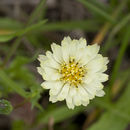Description
(
Inglês
)
fornecido por eFloras
Annuals (sometimes persisting), (5–)20–50(–100+) cm. Stems usually branching from bases and/or distally, rarely scapiform, usually glabrous proximally, sometimes pilosulous. Cauline leaves (1–)3–9+, proximal mostly lanceolate, margins usually dentate, sometimes pinnately lobed, distal narrowly lanceolate to lance-attenuate, margins entire or with 1–2 lobes near bases. Heads (1–)3–5+ in loose, corymbiform arrays. Calyculi: bractlets 13–16+ in 2–3 series, subulate to filiform, 8–12+ mm. Involucres ± cylindric to campanulate, 17–24+ mm. Phyllaries 16–21+. Florets 50–150+; anthers 2.5–3.5 mm (pollen equatorial diameters mostly 43–47 µm). Cypselae: bodies reddish brown, 4–6 mm, beaks 8–10 mm; pappi 7–10+ mm. 2n = 12.
- licença
- cc-by-nc-sa-3.0
- direitos autorais
- Missouri Botanical Garden, 4344 Shaw Boulevard, St. Louis, MO, 63110 USA
Synonym
(
Inglês
)
fornecido por eFloras
Leontodon carolinianum Walter, Fl. Carol., 192. 1788; Pyrrhopappus carolinianus var. georgianus (Shinners) H. E. Ahles; P. georgianus Shinners
- licença
- cc-by-nc-sa-3.0
- direitos autorais
- Missouri Botanical Garden, 4344 Shaw Boulevard, St. Louis, MO, 63110 USA
Pyrrhopappus carolinianus
(
Inglês
)
fornecido por wikipedia EN
Pyrrhopappus carolinianus, commonly called Carolina desert-chicory,[1] or Texas dandelion is in the genus Pyrrhopappus of the family Asteraceae, native throughout Eastern and South Eastern United States. It is an annual found in mostly open grasslands and wet roadsides. P. carolinianus can bloom from spring to frost with the heads facing the sun throughout the day. ”[2]
Description
Pyrrhopappus carolinianus can have more than one erect, flowering stem that can grow up to 50 cm. in length. The leaves are deeply lobed 5-15 cm. long. The smaller upper leaves are slightly indented. The yellow flowers can be up to 3.75 cm. in width. Because it is in the family Asteraceae, it has rays and disc flowers, both of which are yellow.
Pollination
The oligolectic bee, Hemihalictus spp., have been found to be the pollinators for the Carolina desert-chicory. ”[2]
References
-
^ USDA, NRCS (n.d.). "Pyrrhopappus carolinianus". The PLANTS Database (plants.usda.gov). Greensboro, North Carolina: National Plant Data Team. Retrieved 21 June 2016.
-
^ a b Estes, James R.; Thorp, Robbin W. (1975-01-01). "Pollination Ecology of Pyrrhopappus carolinianus (Compositae)". American Journal of Botany. 62 (2): 148–159. doi:10.2307/2441589. JSTOR 2441589.

- licença
- cc-by-sa-3.0
- direitos autorais
- Wikipedia authors and editors
Pyrrhopappus carolinianus: Brief Summary
(
Inglês
)
fornecido por wikipedia EN
Pyrrhopappus carolinianus, commonly called Carolina desert-chicory, or Texas dandelion is in the genus Pyrrhopappus of the family Asteraceae, native throughout Eastern and South Eastern United States. It is an annual found in mostly open grasslands and wet roadsides. P. carolinianus can bloom from spring to frost with the heads facing the sun throughout the day. ”
- licença
- cc-by-sa-3.0
- direitos autorais
- Wikipedia authors and editors
Pyrrhopappus carolinianus
(
Vietnamita
)
fornecido por wikipedia VI
- licença
- cc-by-sa-3.0
- direitos autorais
- Wikipedia tác giả và biên tập viên
Pyrrhopappus carolinianus: Brief Summary
(
Vietnamita
)
fornecido por wikipedia VI
Pyrrhopappus carolinianus là một loài thực vật có hoa trong họ Cúc. Loài này được (Walter) DC. miêu tả khoa học đầu tiên năm 1838.
- licença
- cc-by-sa-3.0
- direitos autorais
- Wikipedia tác giả và biên tập viên

